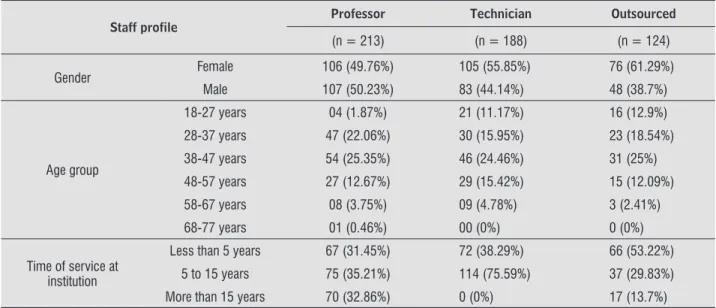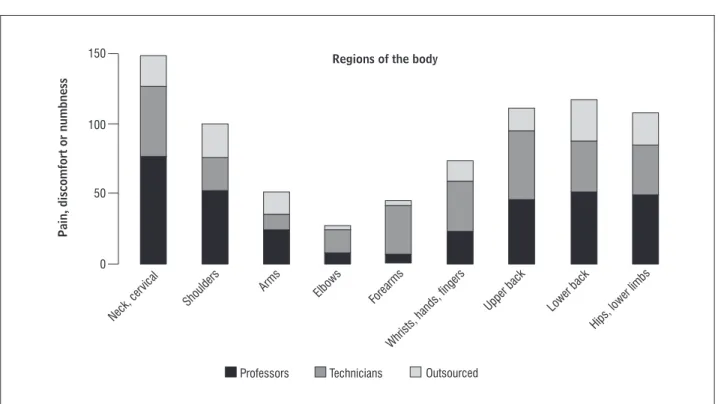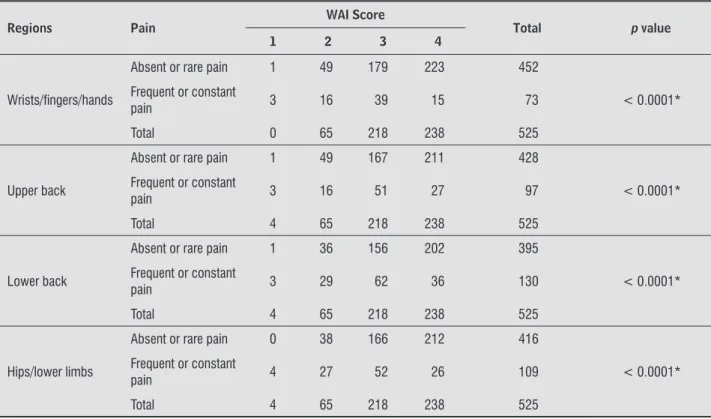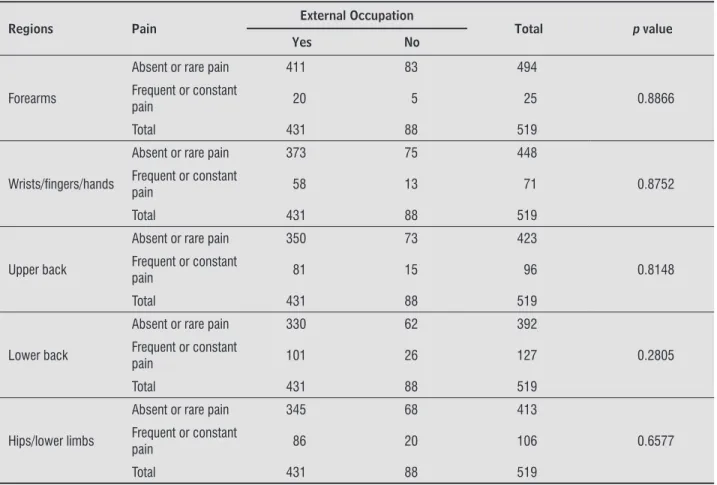Fisioter. Mov., Curitiba, v. , n. , p. - , Apr./June Licenciado sob uma Licença Creative Commons DO): http://dx.doi.org. . / - . . .AO
[T]
Evaluation of musculoskeletal symptoms and of
work ability in a higher education institution
[)]
Avaliação dos sintomas osteomusculares e da capacidade
para o trabalho em uma instituição de ensino superior
[A]
Denise Hollanda Iunes[a], Melissa Louyse Duarte[a], Leticia do Vale Pereira[a],
Murilo César do Nascimento[a], Valdeci Carlos Dionisio[b]*
[a] Universidade Federal de Alfenas Unifal , Alfenas, MG, Brazil [b] Universidade Federal de Uberlândia UFU , Uberlândia, MG, Brazil
[R] Abstract
Introduction: Work-related musculoskeletal disorders WMSDs represent a significant object of study for
the field of occupational health, as they can lead to absenteeism, compensation costs and different levels of functional disability. Nonetheless, there are few studies assessing WMSDs in public higher education
institu-tions. Objective: The present study aimed to investigate, describe and correlate musculoskeletal symptoms
and work ability of staff members of the Federal University of Alfenas Unifal-MG , in the state of Minas Gerais,
Brazil. Materials and methods: A descriptive and correlational study was conducted with professors,
administrative technicians and outsourced staff members using two self-administered questionnaires: the
* D(): PhD, e-mail: denise.iunes@unifal-mg.edu.br
MLD: undergraduate student, e-mail: melissalouyseduarte@hotmail.com LVP: undergraduate student, e-mail: letspereira@hotmail.com
Work Ability )ndex WA) and the Nordic Musculoskeletal Questionnaire NMQ . Results: Most of the teaching
staff presented good work ability . % n = . Among administrative technicians and outsourced staff,
on the other hand, excellent work ability predominated, with . % n = technicians and . % n = outsourced . The most affected region among professors and administrative staff was the neck/cervical area . % n = professors ; and . % n = technicians . Among outsourced staff, the lower back was
reported as the main source of pain, with . % n = . Conclusions: The presence of pain interfered in
the work ability of workers regardless of the affected region. (aving another occupation outside the institution did not influence pain of self-assessed staff members. The work ability of Unifal-MG staff was classified as good or excellent; thus, we recommend preventive work for this population, directed at the physical and mental aspects of work activities in order to maintain or improve such rates.
[P]
Keywords: Cumulative trauma disorders. Work capacity evaluation. Occupational health.
[B]
Resumo
Introdução: Os distúrbios osteomusculares relacionados ao trabalho (Dort) representam preocupação para a saúde ocupacional, uma vez que geram absenteísmo, custos com indenizações, além de diferentes graus de in-capacidade funcional. Mesmo assim, são escassos os estudos que os tenham avaliado em instituições públicas de ensino superior. Objetivo: Este trabalho buscou investigar, descrever e correlacionar os sintomas osteomuscula-res e a capacidade para o trabalho dos servidoosteomuscula-res da Universidade Federal de Alfenas (Unifal-MG), no estado de Minas Gerais. Materiais e métodos: Estudo descritivo-correlacional, que caracterizou 213 professores, 188 téc-nicos administrativos e 124 funcionários terceirizados, por meio de dois questionários autoaplicáveis: o Índice de Capacidade para o Trabalho (ICT) e o Questionário Nórdico de Sintomas Osteomusculares (QNSO). Resultados: A maioria dos professores apresentou boa capacidade para o trabalho 47,9% (n = 102). Já entre os técnicos admi-nistrativos e funcionários terceirizados, predominou ótima capacidade com 43,6% (n = 82 técnicos) e 51,61% (n = 68 terceirizados). As regiões mais acometidas por dor entre os professores e os técnicos administrativos foram o pescoço/região cervical 36,15% (n = 77 docentes); e 28,19% (n = 53 técnicos). Já a região lombar foi a que se destacou entre os terceirizados como a principal fonte de dor, 23,28% (n = 29). Conclusões: A presença de dor interfere na capacidade de trabalho do indivíduo, independente da região acometida. A ocupação externa não influenciou o estado doloroso dos servidores autoavaliados. A capacidade dos colaboradores da Unifal-MG foi classificada como boa ou ótima, por isso sugere-se um trabalho preventivo, com abordagem nos aspectos físicos e mentais da atividade laboral, visando a manutenção ou melhoria desse índice. [K]
Palavras-chave: Distúrbios osteomusculares relacionados ao trabalho. Avaliação da capacidade de trabalho. Saúde do trabalhador.
Introduction
Occupational diseases have been recognized by the Brazilian Ministry of (ealth , since and when such diseases specifically affect the musculo-skeletal system, they are denominated work-related musculoskeletal disorders WMSDs . WMSDs account for most leaves of work - and compen-sation costs , , both in Brazil and in most indus-trialized countries , - . Furthermore, WMSDs can lead to different levels of functional disability,
being considered a severe problem within the field of worker health , , , . A WMSD diagnosis is complicated and frequently delayed, as it is based only on patient complaints, which cannot always be verified , . This characteristic makes treatment difficult and strongly influences the conduct of work-ers in and out of the work environment , - .
299 functional aging that should occur concomitant with
chronologic aging. (owever, in some cases, it occurs precociously due to work conditions . Therefore, evaluating work ability in order to identify its pre-mature decline is of extreme importance for the im-plementation of prevention measures for improving working conditions and avoiding the development of WMSDs , , .
Although research has found a great prevalence of WMSDs among workers in general, there are no studies investigating the work environment of public higher education institutions. Thus, the present study aimed to investigate, describe and correlate musculo-skeletal symptoms and work ability of teaching and administrative staff at a Brazilian higher education institution.
Materials and methods
This was a descriptive and correlational study on the relationship between work ability and musculo-skeletal symptoms, among staff members of the Federal University of Alfenas Unifal-MG , Campus ), Alfenas, in the state of Minas Gerais, Brazil. The study sample comprised professors, admin-istrative technicians and outsourced staff, both men and women, from all work shifts. Of the par-ticipants, were lost to sample attrition. )nclusion criteria were being a staff member at the referred institution and willing to participate. Exclusion crite-ria were having less than a primary level of education and/or being on medical leave of absence or vacation at the time of data collection.
Two self-administered questionnaires were employed: The Work Ability )ndex WA) and the Nordic Musculoskeletal Questionnaire NMQ . The WA) was developed based on studies con-ducted in Finland and was transculturally adapted to Brazilian Portuguese by Tuomi et al. . The translated Portuguese version presented acceptable levels of reliability tested through internal consis-tency Cronbach s alpha . and test-retest with internal consistency of . C) % . to . ; p < . . Cultural validation of the WA) for the Brazilian population took place by comparing it to the Medical Outcomes Study – )tem short form health survey SF- .
The WA) assesses work ability based on worker self-perception , determined by seven items that
investigate ability, health, state of mind and work impairment , . The NMQ was developed by Dickinson et al. and was culturally adapted to Brazil by Barros . Both the original and the Brazilian version presented good levels of reliability, confirmed through test-retest, and satisfactory levels of validity , , . The NMQ was developed with the purpose of standardizing the measurement of re-ported musculoskeletal symptoms and thus facilitate comparability among studies .
Most of the questionnaires were given in person to each staff member in their respective departments and work shifts. )n some cases, when a particular staff member was difficult to find, they were contacted via e-mail. Questionnaires were then given to the department secretaries or sent by e-mail, according to participant preference. All questionnaires were collected a week after delivery.
The data were analyzed using the SPSS version . Statistical Package for the Social Science , andR software, version . . A chi-square test was employed and significance was set at % to verify differences among the results of the three observed groups professors, administrative technicians and outsourced employees . The present study was ap-proved by the research ethics committee protocol no. / ; all participants received information on the objectives of the research and regarding data confidentiality and signed an informed consent form.
Results
The characteristics of the studied sample are de-scribed in Table . The results show that most of the assessed sample consisted of internal staff profes-sors and administrative technicians .
Work ability indexes were heterogeneous among the investigated professional categories, as displayed in Figure . Most staff members presented good and excellent work ability.
technicians were wrists/hands/fingers. Among out-sourced staff, the most reported sites were the lower back, shoulders and hips/lower limbs. Forearms and elbows were the least affected regions in all three groups Figure .
Table presents the NMQ data and its associa-tion with the obtained WA) scores. The results in-dicate that the presence of pain, regardless of the
affected region, interferes with the work ability of staff members.
Table displays the relationship between pres-ence of pain, measured with the NMQ, and whether or not participants held other jobs outside the institu-tion. )n other words, having an occupation external to the institution did not influence the pain experienced by staff members.
Table 1 - Sample characteristics
Staff profile
Professor Technician Outsourced
(n = 213) (n = 188) (n = 124)
Gender Female 106 (49.76%) 105 (55.85%) 76 (61.29%)
Male 107 (50.23%) 83 (44.14%) 48 (38.7%)
Age group
18-27 years 04 (1.87%) 21 (11.17%) 16 (12.9%)
28-37 years 47 (22.06%) 30 (15.95%) 23 (18.54%)
38-47 years 54 (25.35%) 46 (24.46%) 31 (25%)
48-57 years 27 (12.67%) 29 (15.42%) 15 (12.09%)
58-67 years 08 (3.75%) 09 (4.78%) 3 (2.41%)
68-77 years 01 (0.46%) 00 (0%) 0 (0%)
Time of service at institution
Less than 5 years 67 (31.45%) 72 (38.29%) 66 (53.22%)
5 to 15 years 75 (35.21%) 114 (75.59%) 37 (29.83%)
More than 15 years 70 (32.86%) 0 (0%) 17 (13.7%)
Figure 1 - Work Ability Index of Unifal-MG staff (Campus I, Alfenas, Minas Gerais, Brazil)
100
80
60
40
20
0
Low Moderate Good Excellent
1.71%
0.57% 0.00%
3.81% 5.14%
3.05%
8.38% 15.43% 18.29%
16.76%
14.67%
12.19%
Professors Technicians Outsourced
Staff distribution (n = 525)
301
Pain, discomfort or numbness
Regions of the body
Neck, cer vical 150
100
50
0
Shoulders
Arms Elbows
Fore arm
s
Whrists, hands, fingers
Upper back Lower back
Hips, lower limbs
Professors Technicians Outsourced
Figure 2 - Regions most affected by pain, discomfort or numbness among Unifal-MG staff (Campus I, Alfenas, Minas Gerais,
Brazil)
Table 2 - WAI score and presence of pain among Unifal-MG staff (Campus I, Alfenas, Minas Gerais, Brazil)
Regions Pain
WAI Score
Total p value
1 2 3 4
Neck/cervical region
Absent or rare pain 0 39 133 201 373
< 0.0001* Frequent or constant
pain 4 26 85 37 152
Total 4 65 218 238 525
Shoulders
Absent or rare pain 0 40 157 202 399
< 0.0001* Frequent or constant
pain 4 25 61 36 126
Total 4 65 218 238 525
Arms
Absent or rare pain 0 52 188 221 461
< 0.0001* Frequent or constant
pain 4 13 30 17 64
Total 4 65 218 238 525
Elbows
Absent or rare pain 1 59 206 236 502
< 0.0001* Frequent or constant
pain 3 6 11 2 22
Total 4 65 217 238 524
Forearms
Absent or rare pain 1 59 205 234 499
<0.0001* Frequent or constant
pain 3 6 13 4 26
Total 4 65 218 238 525
Table 2 - WAI score and presence of pain among Unifal-MG staff (Campus I, Alfenas, Minas Gerais, Brazil)
Regions Pain
WAI Score
Total p value
1 2 3 4
Wrists/fi ngers/hands
Absent or rare pain 1 49 179 223 452
< 0.0001* Frequent or constant
pain 3 16 39 15 73
Total 0 65 218 238 525
Upper back
Absent or rare pain 1 49 167 211 428
< 0.0001* Frequent or constant
pain 3 16 51 27 97
Total 4 65 218 238 525
Lower back
Absent or rare pain 1 36 156 202 395
< 0.0001* Frequent or constant
pain 3 29 62 36 130
Total 4 65 218 238 525
Hips/lower limbs
Absent or rare pain 0 38 166 212 416
< 0.0001* Frequent or constant
pain 4 27 52 26 109
Total 4 65 218 238 525
Note: *p < 0.05.
(Conclusion)
Table 3 - Presence of pain and performance of other professional activities of Unifal-MG staff (Campus I, Alfenas, Minas
Gerais, Brazil)
Regions Pain
External Occupation
Total p value
Yes No
Neck/cervical region
Absent or rare pain 309 61 370
0.7493 Frequent or constant
pain 122 27 149
Total 431 88 519
Shoulders
Absent or rare pain 329 68 397
0.9591 Frequent or constant
pain 102 20 122
Total 431 88 519
Arms
Absent or rare pain 381 76 457
0.7217 Frequent or constant
pain 50 12 62
Total 431 88 519
Elbows
Absent or rare pain 413 84 497
0.9698 Frequent or constant
pain 17 4 21
Total 430 88 518
303
Table 3 - Presence of pain and performance of other professional activities of Unifal-MG staff (Campus I, Alfenas, Minas
Gerais, Brazil)
Regions Pain
External Occupation
Total p value
Yes No
Forearms
Absent or rare pain 411 83 494
0.8866 Frequent or constant
pain 20 5 25
Total 431 88 519
Wrists/fi ngers/hands
Absent or rare pain 373 75 448
0.8752 Frequent or constant
pain 58 13 71
Total 431 88 519
Upper back
Absent or rare pain 350 73 423
0.8148 Frequent or constant
pain 81 15 96
Total 431 88 519
Lower back
Absent or rare pain 330 62 392
0.2805 Frequent or constant
pain 101 26 127
Total 431 88 519
Hips/lower limbs
Absent or rare pain 345 68 413
0.6577 Frequent or constant
pain 86 20 106
Total 431 88 519
(Conclusion)
Discussion
The relationship observed between physical and mental capacity and respective work ability points to the importance of a psychological and biological ap-proach to enhancing adaptation to the work environ-ment. An example of such interaction was described by Silva et al. , who found that the fear generated by potential loss of employment due to illness was a cause of suffering that was not shared with colleagues and, in some cases, not even with family members. )n the present research, two of the three groups, that is, professors and administrative technicians, consisted of staff members who were admitted via civil service examinations, which implies professional stability. Such job security may have positively influenced the emotional component and, consequently, work abil-ity, which was good or excellent in . % of the sample population.
Comparing the work ability observed in this study, we cite the work of Freude et al. who found
excellent WA) scores in only % of secondary school teachers; most of the cases in the study presented good work ability, followed by moderate and poor. )t is worth emphasizing that preventive actions for such conditions should be implemented before workers be-gin the retirement process. Considering the population of administrative technicians, a study conducted by Martinez and Latorre with workers from the same sector found a greater prevalence of excellent work ability, followed by good, consistent with the findings of the present study. Martinez and Latorre also found that work ability results were associated with job satisfaction among staff members, which interfered in their physical and mental abilities.
in the workplace, massage therapy and postural ori-entation aimed at preventing the development of musculoskeletal symptoms and maintain the levels of work ability found among staff members. Finally, we also suggest a follow-up study to verify the contribu-tion of such preventive accontribu-tion, comparing work abil-ity and musculoskeletal symptoms among the same population after the application of these techniques.
Acknowledgements
We thank the Minas Gerais State Research Foundation Fapemig for the financial support and the Unifal-MG rectory, as well as the availability and consideration of all staff members who participated in the study.
References
. Brasil. Ministério da Sa’de. Secretaria de Atenção à Sa’de. Lesões por esforços repetitivos LER , dist’r-bios osteomusculares relacionados ao trabalho Dort , dor relacionada ao trabalho: protocolos de atenção integral à sa’de do trabalhador de complexidade
dife-renciada. Brasília: Ministério da Sa’de; .
. Maeno M, W“nsch Filho V. Reinserção no mercado de trabalho de ex-trabalhadores com LER/DORT de uma empresa telefônica na região metropolitana de
São Paulo. Rev Bras Sa’de Ocup. ; : - .
. Yu W, Yu )T, Li Z, Wang X, Sun T, Lin (, et al. Work-related injuries and musculoskeletal disorders among factory workers in a major city of China. Accid Anal
Prev. ; : - .
. Eatough EM, Way JD, Chang C(. Understanding the link between psychosocial work stressors and work-related musculoskeletal complaints. Appl Ergon.
; : - .
. Mendes LF, Lancman S. Reabilitação de pacientes com LER/DORT: contribuições da fisioterapia em grupo.
Rev Bras Sa’de Ocup. ; : - .
. Westgaard R(, Winkel J. Occupational musculoskel-etal and mental health: significance of rationaliza-tion and opportunities to create sustainable pro-duction systems; a systematic review. Appl Ergon.
; : - .
high prevalence of musculoskeletal symptoms among teaching staff, with symptoms in % of the teach-ers in the study. The affected regions also converged, namely the upper back, lower back and cervical re-gion. Carvalho and Alexandre also demonstrated that such musculoskeletal discomfort influenced these workers quality of life, as a great portion of profession-als had sought care from some health professional. The same can be said of the current study, as data crossing between NMQ and WA) results revealed that regardless of the affected region, pain exerted a negative influence on the work ability of staff members.
Regarding administrative technicians, the most affected regions were the neck/cervical, shoulder, lower back, hips/lower limbs, upper back, and wrists/ fingers/hands. Other studies conducted with office workers found that workers reported the neck , and shoulders most frequently. De Vitta et al. found that raising awareness among employees regarding the adoption of new postures and the orga-nization of the work environment resulted in reduced frequency of musculoskeletal symptoms. Analysis of the outsourced staff in the present study demonstrat-ed that the most affectdemonstrat-ed sites were the lower back, shoulder and hips/lower limbs. )n studies conducted by Martarello and Benatti in a public municipal hospital with hospital hygiene and sanitation staff, the most prevalent pain complaints involved the shoul-ders, followed by the dorsal region, neck and lower back. Widanarko et al. also reported that workers with high physical demands had a higher prevalence of pain in the neck, shoulders and lower back.
The present study did not corroborate the recur-ring argument that length of work shift in addition to other jobs can influence work ability due to muscle overload and fatigue, favoring the development of musculoskeletal symptoms. The results obtained did not show any connection between variables. Nonetheless, Fernandes et al. suggested that the high prevalence of musculoskeletal symptoms among female teachers can be related to the double burden imposed on this population and emphasized the need for further research in this direction in order to deepen the discussion.
305
. Salim CA. Doenças do trabalho: exclusão,
segrega-ção e relações de gênero. São Paulo Perspec. ;
: - .
. Merlo )RC, Vaz MA, Spode CS, Elbern JLG, Karkow ARM, Vieira PRB. O trabalho entre prazer, sofrimento e adoe-cimento: a realidade dos portadores de lesões por
es-forços repetitivos. Rev Psicol Soc. ; : - .
. Robertson MM, Ciriello VM, Garabet AM. Office er-gonomics training and a sit-stand workstation: ef-fects on musculoskeletal and visual symptoms and
performance of office workers. Appl Ergon. ;
: - .
. Tuomi K, )lmarinen J, Jahkola A, Katajararinne L, Tulkki A. Índice de capacidade para o trabalho. Trad.
Frida Marina Fischer et al. São Paulo: FSPUSP; .
. Dickinson CE, Campion K, Foster AF, Newman SJ, O rourke AMT, Thomas PG. Questionnaire develop-ment: an examination of the Nordic Musculoskeletal
questionnaire. Appl Ergon. ; : - .
. Martinez MC, Latorre MRDO, Fischer FM. Validade e confiabilidade da versão brasileira do Índice de
Ca-pacidade para o Trabalho. Rev Sa’de P’blica. ;
: - .
. Renosto A, Biz P, (ennington EA, Pattussi MP. Confi-abilidade teste-reteste do Índice de Capacidade para o Trabalho em trabalhadores metal’rgicos do Sul do
Brasil. Rev Bras Epidemiol. ; : - .
. Seibt R, L“tzkendorf L, Thinschmidt M. Risk factors and resources of work ability in teachers and office
workers. )nt Congr Ser. ; : - .
. Barros ENC, Alexandre RN. Cross-cultural adaptation of the Nordic musculoskeletal questionnaire. )nt Nurs
Rev. ; : - .
. Dawson AP, Steele EJ, (odges PW, Stewart S. Develop-ment and test-retest reliability of an extended ver-sion of the Nordic Musculoskeletal Questionnaire
NMQ-E : a screening instrument for musculoskeletal
pain. J Pain. ; : - .
. Pinheiro FA, Tróccoli BT, Carvalho CV. Validação do Questionário Nórdico de Sintomas Osteomuscula-res como medida de morbidade. Rev Sa’de P’blica.
; : - .
. Livramento G, Franco T, Livramento A. A ginástica terapêutica e preventiva chinesa Lian Gong/ Qi Gong como um dos instrumentos na prevenção e reabilitação da LER/DORT. Rev Bras Sa’de Ocup.
; : - .
. Widanarko, B, Legg S, Stevenson M, Devereux J, Eng A, Mannetje A, et al. Prevalence of musculoskeletal symp-toms in relation to gender, age, and occupational/
industrial group. )nt J )nd Ergon. ; : - .
. Carvalho AJFP, Alexandre NMC. Sintomas osteomus-culares em professores do ensino fundamental. Rev
Bras Fisioter. ; : - .
. Choobineh A, Motamedzade M, Kazemi M, Moghimbeigi A, Pahlavian A(. The impact of ergonomics intervention on psychosocial factors and musculoskeletal
symp-toms among office workers. )nt J )nd Ergon. ;
: - .
. Fernandes M(, Rocha VM, Costa-Oliveira AGR. Fatores associados à prevalência de sintomas
osteomuscula-res em professoosteomuscula-res. Rev Salud P’blica. ; :
- .
. Santos GLV, Silva )L, Cardoso F, Beresford D. Ocorrência de dist’rbios osteomusculares relacionados ao trab-alho dos professores de uma instituição de ensino
su-perior de Belém/PA. Fisioter Bras. ; : - .
. Walsh )AP, Corral S, Franco RN, Canetti EEF, Alem MER, Coury (JCG. Capacidade para o trabalho em indivíduos com lesões m’sculo esqueléticas crônicas.
Rev Sa’de P’blica. ; : - .
. Augusto VG, Sampaio RF, Tirado MGA, Mancini MC, Parreira VF. Um olhar sobre as LER/DORT no
con-texto clínico do fisioterapeuta. Rev Bras Fisioter. ;
: - .
. De Vitta A, Bertaglia RS, Padovani CR. Efeitos de dois procedimentos educacionais sobre os sintomas mus-culoesqueléticos em trabalhadores administrativos.
Rev Bras Fisioter. ; : - .
. Barbosa MSA, Santos RM, Trezza MCSF. A vida do tra-balhador antes e após a Lesão por Esforço Repetitivo
LER e Doença Osteomuscular Relacionada ao
Tra-balho DORT . Rev Bras Enferm. ; : - .
. Verthein MAR, Minayo-Gomez C. A construção do su-jeito-doente em LER. (ist Cien Saude-Manguinhos.
. Martarello NA, Benatti MCC. Qualidade de vida e sintomas osteomusculares em trabalhadores de higiene e limpeza hospitalar. Rev Esc Enferm USP.
; : - .
Received: / / Recebido: / /
Approved: / / Aprovado: / /
. Silva EF, Oliveira KKM, Souza PCZ. Sa’de mental do trabalhador: o assédio moral praticado contra tra-balhadores com LER/DORT. Rev Bras Sa’de Ocup.
; : - .
. Freude G, Seibt R, Pech E, Ullsperger P. Assessment of work ability and vitality: a study of teachers of
dif-ferent age groups. )nt Congr Ser. ; : - .
. Martinez MC, Latorre MRDO. Sa’de e capacidade para o trabalho em trabalhadores da área administrativa.
Rev Sa’de P’blica. ; : - .
. Andersen LL, Christensen KB, (oltermann A, Poulsen OM, Sjøgaard G, Pedersen MT, et al. Effect of physical exercise interventions on musculoskeletal pain in all body regions among office workers: a one-year



